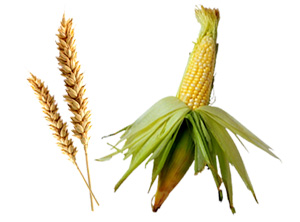 Grains were relatively steady during pre-noon trade in Europe today. Yesterday, wheat and corn dropped as weather over the US was forecast to be favorable for crops. Soybeans gained on tight supplies worldwide. Heat and drought concerns over Russia and Kazakhstan offered some support for wheat.
Grains were relatively steady during pre-noon trade in Europe today. Yesterday, wheat and corn dropped as weather over the US was forecast to be favorable for crops. Soybeans gained on tight supplies worldwide. Heat and drought concerns over Russia and Kazakhstan offered some support for wheat.
Weather reports for Europe project a very hot and dry, potentially damaging weather over key regions. The south Volga region in Russia, and western Kazakhstan will see a build up of high pressure, lowering the chance of much-needed rains and further increasing temperatures, reaching into the 90s. Ukraine will have scattered showers, which will ease crops. Over the US the week will be mostly favorable. The Midwest might expect some slowdown in planting activities, due to localized rains. The northern Plains will be warming and drying up in the following days, improving conditions for fieldwork. The southern Plains will see two or three more days of dry heat, followed by much awaited rains, which will ease winter wheat, delaying fieldwork at the same time. However, more heat might be coming to the region next week. The Delta will be warm and dry.
Wheat
Wheat futures for July delivery on the Chicago Board of Trade stood at $6.696 per bushel, dropping 0.11% at 11:52 GMT today. Daily high and low were at $6.754 and $6.664 per bushel, respectively. Yesterday the contract lost 0.59% after falling almost 7% last week.
“Temperatures in Russia, specifically the Volga district, have soared with certain key growing areas now more than 10 degrees Celsius higher than normal, which has the potential to hurt production potential,” U.K. grains trader Gleadell Agriculture Ltd. wrote in a comment today.
The potentially harmful conditions over key wheat-producing regions in Russia and Kazakhstan did offer support for wheat. However, globally rising supplies and improving conditions over the US pared any gains.
“The market is locking in on the idea that El Nino will lead to a big U.S. crop and lower prices,” said for Bloomberg Greg Grow, director of agribusiness at Archer Financial Services Inc. in Chicago.
The weekly National Agricultural Statistics Service (NASS) report, released on Monday, revealed 57% of winter wheat acreage in the 18 major states has headed by May 18, in line with the 5-year average. Meanwhile, 44% of crops were reported in poor or very poor condition, while only 29% were said to be better than average.
Spring wheat planting in the 6 states, accounting for 99% of the production, was lagging behind historic figures. Only 49% of planned crops have been planted, behind 68% for the 5-year average, while only 24% have emerged, below the 40% 5-year average.
Soybeans
Soybean futures for July traded for $14.764 per bushel in Chicago at 11:59 GMT today, adding 0.46%. Prices ranged between $14.674 and $14.792 per bushel. Yesterday the contract lost 1.04% after a 1.38% gain on Monday.
The US Department of Agriculture reported a 64% annual increase in inspected and ready for export soybeans, a report on Monday revealed. Shipments also added 22%. US stockpiles before the start of the 2014 harvest are expected to stand at 3.8% of domestic consumption plus exports, indicating razor thin inventories.
“We don’t have 90 million sold yet to the U.S.,” said for Bloomberg Dan Cekander, director of grain market research at Newedge USA LLC in Chicago. “Supplies are going to be tight.”
The NASS report also showed soybeans planting was also lagging behind the average for the week through May 18. 33% of acreage across the 18 major states was planted, while the 5-year average is at 38%.
Meanwhile, 9% of soybean acreage had already emerged. Last year the standing for the period was at 3%, while the 5-year average is at 11%.
Corn
Corn futures for July traded for $4.634 per bushel in Chicago at 12:00 GMT today, unchanged for the session. Prices reached a daily high and low at $4.760 and $4.724 per bushel, respectively, reaching recording the deepest trough in six weeks. Yesterday the contract fell by 0.79%, after a further 1.29% loss on Monday.
“Weather looks good for farmers to make excellent progress finishing up planting this week,” said for Bloomberg Greg Grow, the director of agribusiness at Archer Financial Services Inc. in Chicago. “The warmer temperatures will help corn plants to get off to a very good start.”
The NASS report showed 73% of corn acreage across 18 major states was planted by May 18, after the recorded 59% last week. The 5-year average for the week is at 76%, while last year the reading was at 65%.
Meanwhile, 34% of corn crops had emerged, after 18% last week. Last year’s reading for the period stood at 17%, while the 5-year average is at 42%.
Technical view
According to Binary Tribune’s daily analysis, wheat for July on the CBOT will see its resistance levels at $6.8227, $6.9413 and $7.0227 per bushel. Support points are estimated at $6.6227, $6.5413 and $6.4227 per bushel.
Corn will have resistance at $4.7873, $4.8407 and $4.8693 per bushel, while support levels are calculated at $4.7053, $4.6767 and $4.6233 per bushel.
Soybeans will have resistance at $14.9093, $15.1227 and $15.2353 per bushel, while support is expected at $14.5833, $14.4707 and $14.2573 per bushel.





